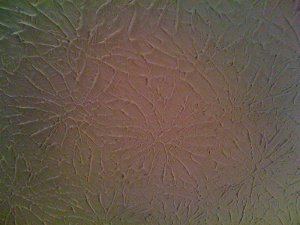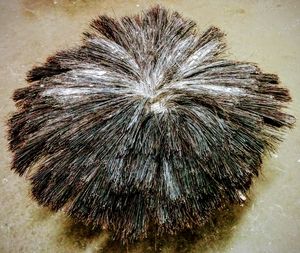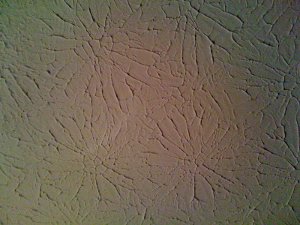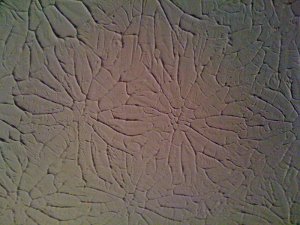
Rosebud Drywall Texture
Rosebud stomp drywall texture is very common on ceilings throughout the Midwest United States. The name Rosebud refers to the way the texture looks like an opened rose flower with petals rolling out from the center in a circular pattern.
Rosebud drywall texture is popular mostly because of its ease of application. Also, it does very well at covering imperfections in the drywall surface. Rosebud drywall texture is created by first applying a very thin layer of drywall mud to the entire surface. Then while the mud is still wet, a Rosebud soft-bristle stomp brush is stomped evenly across the entire area. Rosebud drywall texture is applied primarily to ceilings. It is often paired with smooth finish on the walls. Rosebud drywall texture is rarely applied to walls.
How to Apply Rosebud Drywall Texture
The key to applying Rosebud texture, as with most drywall texture styles, is using drywall mud of the proper consistency. Any type of drywall mud may be used. however, All-Purpose Drywall Compound or Topping Compound are best suited for drywall texture mud. Lightweight drywall mud can also be used, but it is not recommended. Lightweight drywall mud contains fewer gluing agents which can cause it to set differently than other types of drywall mud.
Drywall mud used for Rosebud drywall texture needs to be thinned considerably. If the texture mud is too thick, the resulting stomp texture will have very sharp edges. Thinner mud tends to smooth out the texture and produces more consistent coverage.
 Tradesmen use varying techniques to determine how much water to add when mixing texture mud. One technique requires the use of a heavy-duty electric drill attached to a drywall mud mixing paddle. Water is added to the drywall mud while spinning the mud in a five-gallon bucket. The spinning paddle will create a vortex in the bucket of mud that extends to the top of the drywall paddle, nearly the entire way down the bucket. Water needs to be added gradually to prevent it from sloshing out while mixing.
Tradesmen use varying techniques to determine how much water to add when mixing texture mud. One technique requires the use of a heavy-duty electric drill attached to a drywall mud mixing paddle. Water is added to the drywall mud while spinning the mud in a five-gallon bucket. The spinning paddle will create a vortex in the bucket of mud that extends to the top of the drywall paddle, nearly the entire way down the bucket. Water needs to be added gradually to prevent it from sloshing out while mixing.
Application of Rosebud drywall texture is fairly easy. The most common way to apply texture is using a paint roller with a three-quarter-inch nap roller cover. Evenly applying the drywall mud across the entire surface is critical. Though not difficult, it takes some practice to know how to roll mud consistently. Again, thin drywall mud makes it easier to get a consistently even layer of texture mud.
It is good to work in eight-foot sections at a time. This helps ensure that the texture material does not dry out before it can be stomped. You must be careful to maintain a wet edge across the entire area of texture. One section of texture cannot be allowed to dry before you overlap the texture mud for the next section. To stomp a Rosebud pattern in this type of texture a round brush with three to four-inch long soft bristles is used. The rosebud brush can be attached to an extension pole to assist in stomping.
Pictures of a Rosebud Drywall Texture Stomp Brush
Another technique for applying texture mud is using an airless paint sprayer. This is by far the best way to apply drywall mud evenly. Using an airless paint sprayer to do Rosebud drywall texture is best done with at least 4 people. One person to run the sprayer, a second to stomp the pattern, a third person to mix texture mud and ensure the pump never runs dry, and a fourth person to clean up the angles.
Not all airless paint sprayers are powerful enough to spray drywall texture mud. Airless paint sprayers are not the same as texture sprayers used for Splatter Knockdown drywall texture. Equipment rental suppliers should be able to answer any questions you may have when looking for equipment.
Take a look at some pictures of examples of Rosebud Drywall texture below. You can click on any picture to see a larger version.
Usually, Rosebud drywall texture is only applied on the ceilings. It is often paired with Smooth Wall Texture. Occasionally it is paired with another type of texture on the walls. Please read this article that discusses more how to match wall and ceiling textures. It includes some pictures of Rosebud texture on ceilings with a different type of texture on the walls.




